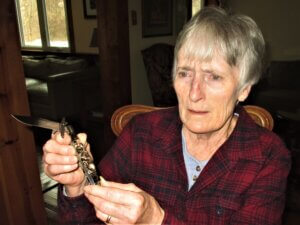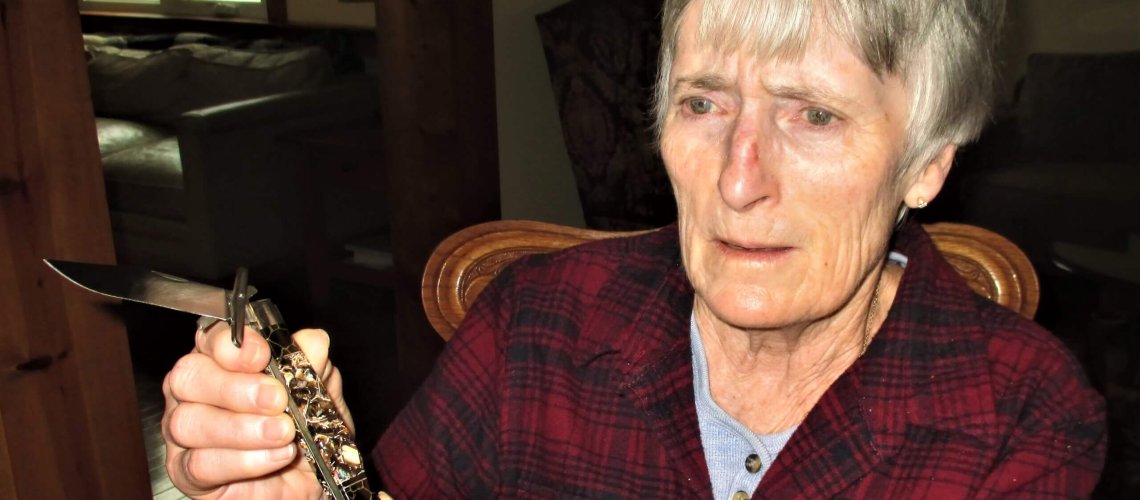
What is my Knife Worth?
(Or how can I sell my knife for the most money?)
Dan Lago and Fred Fisher, 6-15-2023
Without doubt, the most common questions that knife collectors get can be summarized as “How much MONEY is my knife worth?” We offer a commentary and then offer some ways to make selling a knife more profitable.
First, true knife collectors DO NOT WANT TO HELP YOU SELL A KNIFE FOR MORE MONEY – It increases the chances they will also have to pay more for future knives they want to acquire. Almost all knife collectors love to tell the story about how they got a valuable knife for next to nothing, because “Somebody didn’t know what they were selling!” In general, collectors want to keep knife prices LOW. Of course, over the long haul, we try to provide information about the knives in our own collections so their values go up if we ever have to sell our own knives – or preferably, pass them on to our younger family in a more valuable state than when we acquired them.
Second, collectors DO like very much to talk with someone about the intrinsic qualities of a knife, rather than talk just about money. For us the knife, its characteristics and history matter a lot. The steel used, the handle materials, details of construction, how dates of production based on a knife’s details, model numbers, etc. are all of interest to us. This is how we learn – a little bit from every knife we meet.
After talk with one of us, one candid seller exclaimed, “I have just learned three times as much as I never wanted to know! JUST TELL ME WHAT IT WILL SELL FOR! ” We are always hoping to guide someone toward improving their collection and appreciating the knife they own, So, it is a bit depressing to see the knife we talked about for sale the next day (usually at the very highest point we casually mentioned), It saddens us to see an interesting knife treated as “just a commodity”.
Third, and most important, selling any knife involves a CONTEXT – situations that go way beyond the knife itself, that we, or any advisor, cannot know. For example: Are you planning on selling to one person, at a local flea market with a possible audience of 30 potential buyers, or a heavily advertised major Internet auction attracting thousands of wealthy potential buyers?
Fourth, How have knife prices for your particular pattern changed recently? Many of us have seen Queen and Schatt & Morgan prices go up since the company closed its doors in 2018, and we therefore cannot not buy as much as before. We frequently complain that we cannot add more knives to our own collections because they now cost too much. Especially across favored knife patterns, we cannot actively monitor prices across various knife shows or Internet sites. Indeed, we may not be especially accurate or timely in valuing a particular knife, but if pressed, we still might throw out a number or a range. So, our opinions may not truly capture what you should expect from a sale. Sorry! It is just not our job and might even represent a conflict of interest. We know very little about these larger contexts.
How to sell your knife for more money.

We do appreciate the basic idea that information in the seller’s hands generally transfers to getting more money for a knife, but we think the best way is to add to your own learning rather than generally trust an available collector. So, if you are in a HURRY for money, expect to get less per knife. Sell a bunch at once to a buyer who will pay only wholesale prices. Generally, a dealer who plans to re-sell your knife will only pay roughly 50% of the presumed value of a knife – less if possible. He/she has costs involved in selling and does want to make a profit. Yes, even here, some documentation of what you have is necessary. Always try to find a way to show your knives to multiple buyers. Competition is how you sell for more money.
If you are are committed to gaining more information before selling, we emphasize three categories – Rarity, desirability, and condition.
Rarity. How many of a knife were originally produced. Some knives were never offered in a catalog and made for a very short time. Some much older knives have survived, so age adds to rarity. Some makers have started making knives in very small editions, or adding etches that make it seem the knife is rare – “Prototype,” “Factory Sample.” Or limited-edition numbers on a knife such as: “1-100,” “1-30,” “1 of 1”. Some of this is pure marketing, or may be the truth. Regardless, if you can document rarity always do so. (If you can be shown to use this claim falsely, people might want their money back and if you plan to sell multiple knives you will clearly lose respect and potential buyers.)
Desirability. How well made and beautiful is the knife. How many people would say, “Oh boy! do I want that knife!” This is the factor that resides in the mind of potential buyers and the emphasis of their collection. It is most difficult for a seller to estimate. A clear, factual description of the knife and manufacturer can help to increase desirability. Older knives that can be documented by tang stamps or maker’s names will bring more money. Exotic handle materials like Mammoth ivory, Mother of Pearl, Stag, micarta or similar eye-catching modern synthetic handles will increase selling prices.
Condition. How much use or abuse has the knife suffered. Rust or crude sharpening efforts, cracks or broken handle material, poor mechanical function are traditional knife evaluation factors. While “mint” is often used to describe knives, it is overused. “Fit” describes how well handle materials are smooth and tight – no gaps. “Function” describes if blades are well centered and snap open and closed properly. These kind of descriptors can also open up a seller to complaints, because they are hard to evaluate from a few photographs. There are no official agreed-upon criteria, for condition, so each potential buyer gets to make their own assessment.
In modern collecting, the quality of the packaging and any insert material might be important to some collectors. They can help date the knife and can help distinguish factory knives from “parts” knives and counterfeit knives. So, Is the knife Complete?
In the end, you and your buyers need to negotiate a price that you both think is fair.
Most of the following recommendations assume sale on Internet:
- Clean the knife so you can examine details so you can study what you have. – NOT “overcleaning” on older knives – Leave the “patina.” Heavy sanding or grinding will destroy value.
- Identify company that produced the knife, name, model number, time likely produced. Take photo of knife and tang stamp or blade etch. The basic strategy is to measure the knives CLOSED, and count the number and type of blades.
- Prepare photos. Do not use stock photos for sale as people will want to examine the specific knife in detail. Make sure the photos are well focused – any “blur” will lose bidders. We generally feel better about buying a knife where the focus of the pictures are the knife itself, rather than a crowded “artsy” image. Include the box and label if possible. More than one photo is always a good idea.
- Check with Internet resources for information that shows the knife is special or has a history. We show a number of sources Queen and Schatt & Morgan knives in our reference section below:
- Use “collector websites” that provide consultation on knife values, such as ours. Provide photos and try to have a phone conversation. We do try to help, despite our initial comments – we are always hoping to spread more information.
- Write description that includes size, blades, handle material, best estimate of date of production (from tang stamp) and any details you have found in your search, including any photos. The more you have a foundation of knowledge, the faster you can get to this point. Post for sale.
- If you get questions or issues on your post, try to answer quickly. Those might be the biggest spenders. Good luck!
References
Both the following sites have identical tang and etch guides that are very detailed for 1900-2017, including Schatt & Morgan, Queen City, Queen Cutlery, Dollar knives, Robeson after 1993, and Tuna Valley, 2012-2017,and axes, razors and scissors. (Avoid using the early tang guides which cover only earlier years, are much shorter and to our thinking are NOT very accurate)
Depending on your interests, either site above may be helpful to you. They are both loaded with knife and historical information.
All About Pocket Knives – Home Page
This site contains a forum for Queen, Schatt & Morgan and other companies, and a selling section for knives by brand names that keep photos online after sales are completed. Use detailed search terms. So, you can learn more about what your particular knife is currently offered for sale and what it actually sold for – very useful.
Electronics, Cars, Fashion, Collectibles & More | eBay. sells many knives, so you can look for knives similar to what you plan to sell. Use detailed search terms. Earlier sales are not available. Sellers may not know what they have and misinformation is readily available, but it is a common sale site.
So, maximizing sale prices takes a little work – but if you have many knives it becomes much easier. Think of it as fun!


